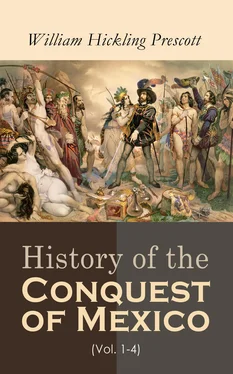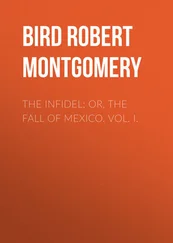Such was the form of human sacrifice usually practised by the Aztecs. It was the same that often met the indignant eyes of the Europeans in their progress through the country, and from the dreadful doom of which they themselves were not exempted. There were, indeed, some occasions when preliminary tortures, of the most exquisite kind,—with which it is unnecessary to shock the reader,—were inflicted, but they always terminated with the bloody ceremony above described. It should be remarked, however, that such tortures were not the spontaneous suggestions of cruelty, as with the North American Indians, but were all rigorously prescribed in the Aztec ritual, and doubtless were often inflicted with the same compunctious visitings which a devout familiar of the Holy Office might at times experience in executing its stern decrees. [127]Women, as well as the other sex, were sometimes reserved for sacrifice. On some occasions, particularly in seasons of drought, at the festival of the insatiable Tlaloc, the god of rain, children, for the most part infants, were offered up. As they were borne along in open litters, dressed in their festal robes, and decked with the fresh blossoms of spring, they moved the hardest heart to pity, though their cries were drowned in the wild chant of the priests, who read in their tears a favorable augury for their petition. These innocent victims were generally bought by the priests of parents who were poor, but who stifled the voice of nature, probably less at the suggestions of poverty than of a wretched superstition. [128]
The most loathsome part of the story—the manner in which the body of the sacrificed captive was disposed of—remains yet to be told. It was delivered to the warrior who had taken him in battle, and by him, after being dressed, was served up in an entertainment to his friends. This was not the coarse repast of famished cannibals, but a banquet teeming with delicious beverages and delicate viands, prepared with art, and attended by both sexes, who, as we shall see hereafter, conducted themselves with all the decorum of civilized life. Surely, never were refinement and the extreme of barbarism brought so closely in contact with each other. [129]
Human sacrifices have been practised by many nations, not excepting the most polished nations of antiquity; [130]but never by any, on a scale to be compared with those in Anahuac. The amount of victims immolated on its accursed altars would stagger the faith of the least scrupulous believer. Scarcely any author pretends to estimate the yearly sacrifices throughout the empire at less than twenty thousand, and some carry the number as high as fifty thousand! [131]
On great occasions, as the coronation of a king or the consecration of a temple, the number becomes still more appalling. At the dedication of the great temple of Huitzilopochtli, in 1486, the prisoners, who for some years had been reserved for the purpose, were drawn from all quarters to the capital. They were ranged in files, forming a procession nearly two miles long. The ceremony consumed several days, and seventy thousand captives are said to have perished at the shrine of this terrible deity! But who can believe that so numerous a body would have suffered themselves to be led unresistingly like sheep to the slaughter? Or how could their remains, too great for consumption in
FRA BARTOLOMÉ DE LAS CASAS
Goupil & Cº. Paris
the ordinary way, be disposed of, without breeding a pestilence in the capital? Yet the event was of recent date, and is unequivocally attested by the best-informed historians. [132]One fact may be considered certain. It was customary to preserve the skulls of the sacrificed, in buildings appropriated to the purpose. The companions of Cortés counted one hundred and thirty-six thousand in one of these edifices! [133]Without attempting a precise calculation, therefore, it is safe to conclude that thousands were yearly offered up, in the different cities of Anahuac, on the bloody altars of the Mexican divinities. [134]
Indeed, the great object of war, with the Aztecs, was quite as much to gather victims for their sacrifices as to extend their empire. Hence it was that an enemy was never slain in battle, if there were a chance of taking him alive. To this circumstance the Spaniards repeatedly owed their preservation. When Montezuma was asked “why he had suffered the republic of Tlascala to maintain her independence on his borders,” he replied, “that she might furnish him with victims for his gods”! As the supply began to fail, the priests, the Dominicans of the New World, bellowed aloud for more, and urged on their superstitious sovereign by the denunciations of celestial wrath. Like the militant churchmen of Christendom in the Middle Ages, they mingled themselves in the ranks, and were conspicuous in the thickest of the fight, by their hideous aspect and frantic gestures. Strange, that, in every country, the most fiendish passions of the human heart have been those kindled in the name of religion! [135]
The influence of these practices on the Aztec character was as disastrous as might have been expected. Familiarity with the bloody rites of sacrifice steeled the heart against human sympathy, and begat a thirst for carnage, like that excited in the Romans by the exhibitions of the circus. The perpetual recurrence of ceremonies, in which the people took part, associated religion with their most intimate concerns, and spread the gloom of superstition over the domestic hearth, until the character of the nation wore a grave and even melancholy aspect, which belongs to their descendants at the present day. The influence of the priesthood, of course, became unbounded. The sovereign thought himself honored by being permitted to assist in the services of the temple. Far from limiting the authority of the priests to spiritual matters, he often surrendered his opinion to theirs, where they were least competent to give it. It was their opposition that prevented the final capitulation which would have saved the capital. The whole nation, from the peasant to the prince, bowed their necks to the worst kind of tyranny, that of a blind fanaticism.
In reflecting on the revolting usages recorded in the preceding pages, one finds it difficult to reconcile their existence with anything like a regular form of government, or an advance in civilization. [136]Yet the Mexicans had many claims to the character of a civilized community. One may, perhaps, better understand the anomaly, by reflecting on the condition of some of the most polished countries in Europe in the sixteenth century, after the establishment of the modern Inquisition,—an institution which yearly destroyed its thousands, by a death more painful than the Aztec sacrifices; which armed the hand of brother against brother, and, setting its burning seal upon the lip, did more to stay the march of improvement than any other scheme ever devised by human cunning.
Human sacrifice, however cruel, has nothing in it degrading to its victim. It may be rather said to ennoble him by devoting him to the gods. Although so terrible with the Aztecs, it was sometimes voluntarily embraced by them, as the most glorious death and one that opened a sure passage into paradise. [137]The Inquisition, on the other hand, branded its victims with infamy in this world, and consigned them to everlasting perdition in the next.
One detestable feature of the Aztec superstition, however, sunk it far below the Christian. This was its cannibalism, [138]though, in truth, the Mexicans were not cannibals in the coarsest acceptation of the term. They did not feed on human flesh merely to gratify a brutish appetite, but in obedience to their religion. Their repasts were made of the victims whose blood had been poured out on the altar of sacrifice. This is a distinction worthy of notice. [139]Still, cannibalism, under any form or whatever sanction, cannot but have a fatal influence on the nation addicted to it. It suggests ideas so loathsome, so degrading to man, to his spiritual and immortal nature, that it is impossible the people who practise it should make any great progress in moral or intellectual culture. The Mexicans furnish no exception to this remark. The civilization which they possessed descended from the Toltecs, a race who never stained their altars, still less their banquets, with the blood of man. [140]All that deserved the name of science in Mexico came from this source; and the crumbling ruins of edifices attributed to them, still extant in various parts of New Spain, show a decided superiority in their architecture over that of the later races of Anahuac. It is true, the Mexicans made great proficiency in many of the social and mechanic arts, in that material culture,—if I may so call it,—the natural growth of increasing opulence, which ministers to the gratification of the senses. In purely intellectual progress they were behind the Tezcucans, whose wise sovereigns came into the abominable rites of their neighbors with reluctance and practised them on a much more moderate scale. [141]
Читать дальше












